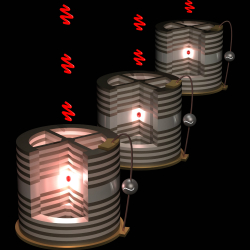A solid-state platform for quantum technologies
Photons are attractive candidates for both classical and quantum information processing, where they act as carriers of information. Efficient photon generation and routing, however, necessitates the development of optical devices that work at low photon numbers and reach single emitter-single photon levels. The ideal single-photon source would produce light pulses, each containing no more than one photon. Additionally, all photons would be identical in all their degrees of freedom such as wavelength and polarisation. To develop even near-optimal single-electron sources, researchers had to overcome many scientific and technological difficulties. In the European Research Council (ERC)-funded project QD-CQED (A quantum dot in a cavity: A solid state platform for quantum operations), they designed the first optoelectronic devices made of quantum dots precisely positioned in electrically controlled microcavities. Obtaining efficient sources producing highly indistinguishable single photons was the result of several years of research. The challenge of perfection ‘Advanced quantum protocols require quantum systems that are isolated from their environment and decoherence phenomena are minimised,’ notes Dr Pascale Senellart from Centre national de la recherche scientifique (CNRS), principal investigator of QD-CQED. Obviously, this was not the case for a solid-state photon emitter, inserted in a vibrating and fluctuating environment. Moreover, to reach the single emitter-single photon level, researchers had to couple a quantum dot to a microcavity and engineer the electromagnetic field around the emitter and force it to emit in a well-defined mode of the optical field. ‘During the course of the project, we progressively understood that we could reduce both fluctuating charges and phonons – the effects of vibrations on the electronic excitation of the solid structure. To that end, we confined the optical field both spatially and temporally, while applying the electric field on the emitter,’ she says. Unlike existing techniques that involve covering the cavity with a polymer, the QD-CQED team connected pillar-shaped cavities of a few microns’ in diameter to bigger frames using 1D wires. The innovative configuration (illustrated in the image) was instrumental in suppressing the effects of the solid-state surrounding of the emitter. ‘We could show that our artificial atom, the quantum dots consisting of thousands of atoms when inserted in a solid-state matrix, presents optical properties similar to a single natural atom in a vacuum. Importantly, our solid-state implementation offers the advantages of integration and scalability,’ explains Dr Senellart. Well beyond expectations The new source technology provides high-quality single photons with brightness exceeding that of existing sources by one order of magnitude. Importantly, it has contributed to scaling up intermediate quantum computing tasks, such as the so-called boson sampling performed significantly faster than with the usual source technology. The potential of the QD-CQED technology is reflected in the Nature Photonics paper(opens in new window) that was among the 0.1 % most cited papers in academic physics for the year 2016. An increasing number of collaborations with researchers from the quantum optics community are being established to utilise the sources. To date, the sources have been utilised to implement an intermediate optical computing protocol and to demonstrate two-photon gates. The team has also shown that it is possible to effectively control a stationary quantum bit with pulses of light embedding only a few photons. Dr Senellart-Mardon concludes by saying: ‘A spin-off company will be created in 2017 to allow a wider community to benefit from this progress. Two young researchers are behind this initiative; both have been supported in their research endeavours by QD-CQED. The future of optical quantum technologies appears bright!’







